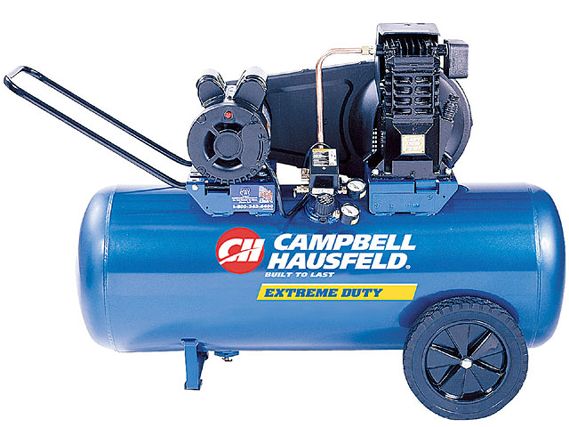 | Campbell Hausfeld 26-Gallon Air Compressor - Tool Of The Month
| Campbell Hausfeld 26-Gallon Air Compressor - Tool Of The Month
Heavy shop equipment-stuff like air compressors, big bench vices, parts washers and hydraulic presses-is what separates the serious home shop gearhead from the dabblers in our ranks. It isn't for everyone, being in that first group, and it's not cheap. First, you need a garage, which unfortunately eliminates many of our brethren condemned to renting or urban dwelling. Second, we have to spend money to save money. One reason professional shops charge so much is to pay for tool and equipment overhead. But if you're serious about working on cars in your home garage, one of the must-haves is a decent air compressor.
Air compressors are used to power all manner of pneumatic tools, some of which are almost mandatory while others are mere time-savers. In the automotive realm, these include air ratchets, impact guns, pneumatic drills, cutting tools, sanders and spray guns. There are also more specialized pneumatic automotive tools, like Vacula suction-type brake bleeders and cylinder leakdown diagnostic tools, and let's not forget the simple stuff, like air chucks for tire inflation and the good old blow gun for general purposes like cleaning and detailing, not to mention brake caliper rebuilding. Almost all can now be purchased at a relatively low cost due to the "good side of globalization." You may think you don't need an air compressor to work on cars, and you're right; you don't need one. But if you ever get a chance to use pneumatic tools, an air compressor will become your highest priority not medically characterized as surgery.
My friend Vince, with whom I used to work on cars until he retired to a life of leisure, has a massive upright air compressor with a 100-gallon air tank. It runs on 230 volts, dims the lights in his house when it kicks on, sounds like the Hindenburg and scares small children. It can paint small ships with one tank of air. Green in color, it dates from the 1950s and is so heavy we had to call a tow truck to pick the thing up each of the four times we've moved it in the last 20 years. It once lived at my old garage in Scranton, Penn., behind a 100-year-old Victorian, where it sank about three inches into the godforsaken asphalt floor someone thought would be a good idea back in the 1920s. Today, a similar compressor would cost thousands of dollars. Once Vince discovered bocce ball and John Deer tractors, I needed my own compressor, but it had to be affordable. And, having moved Big Green a few times, I wanted an air tank on wheels.
There are a few other caveats, too: Buy the largest compressor you can afford. It never hurts to have too much capacity, but too little capacity will hinder your work. For automotive work, a 20-gallon capacity is pretty much the smallest you should consider. Make sure you buy an oil-filled engine, as the new oilless designs last about as long as you would expect an engine to last without oil-common sense prevails once again. Oilless designs are also very loud, and they run very hot. Solid cast iron units are up to 35% quieter than aluminum units with cast iron cylinder sleeves, and dramatically quieter than direct drive aluminum compressors. Use SAE 30-W nondetergent motor oil in air compressor engines in most climates, unless you live where it is very cold and the engine is stored in an unheated location, in which case you should use SAE 10-W nondetergent motor oil. Change the oil at least once a year, more if you use the compressor often. If the oil drain is obscured so that oil drains onto the compressor itself, fit a short piece of threaded copper pipe with an end plug as an extension. You can buy these at Home Depot. If at all possible, get a 220- to 230-volt air compressor. It will use less electricity, but you'll have to wire up a special outlet. Finally, drain condensation water from the tank frequently.
I found what, for me, is the perfect air compressor from Campbell Hausfeld. It's the company's Model VT6271, a single-stage, two cylinder, 3-hp cast iron portable unit with a 26-gallon tank, running on 230 volts. It carries a three-year warranty and pushes 10.3 cfm at 90 psi, with a maximum of 135 psi output. With air flow usually found in big stationary compressors, this unit offers enough power to attack big projects. The twin-cylinder, oil-lubricated, single-stage pump is pretty quiet. Cost was $534 retail; street price is a bit lower.
This unit does everything I need it to do, and it will even paint a car-although it doesn't shut off if you're using a high-pressure spray gun. It's quiet enough that my neighbors don't care, and I can roll it outside if its presence is required off-site. As an example of savings, if you want to change your own brake fluid once a year and use a good Vacula tool, shops often charge about $150. So the tools required pay for themselves in five years or so, just on this one job alone.
The downside? Having an air compressor can make you the most popular kid on the block when your friends need to use it.
